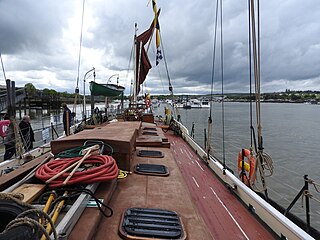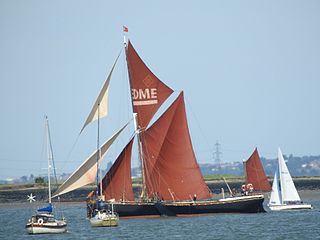
A Thames sailing barge is a type of commercial sailing boat once common on the River Thames in London. The flat-bottomed barges, with a shallow draught and leeboards, were perfectly adapted to the Thames Estuary, with its shallow waters and narrow tributary rivers. The larger barges were seaworthy vessels, and were the largest sailing vessel to be handled by just two men. The average size was about 120 tons and they carried 4,200 square feet (390 m2) of canvas sail in six working sails. The mainsail was loose-footed and set up with a sprit, and was brailed to the mast when not needed. It is sheeted to a horse, as is the foresail; they require no attention when tacking. The foresail is often held back by the mate to help the vessel come about more swiftly.

Thalatta is a Thames sailing barge, built in Harwich, Essex, in 1906 and rebuilt in St Osyth in 2012. She is 90 feet (27 m) long and 26 feet (7.9 m) across the widest part of the deck. Like all Thames barges, she is flat-bottomed and has leeboards instead of a keel. She spent some of her life ketch-rigged and some of it spritsail-rigged. She is now permanently spritsail rigged, and has a mainmast and topmast that, together, are about 90 feet (27 m) high, and a mizzen mast. Thalatta has had two periods with an auxiliary engine and two without. She carried cargo for sixty years and was then converted for use as a sail training ship in 1966. She was completely rebuilt between 2006 and 2012 at St Osyth with assistance from lottery funds.

Lady of the Lea is a spritsail Thames sailing barge, the last such barge to be built in England. She was built in 1931 to carry explosives from Waltham Abbey Royal Gunpowder Mills on the River Lea to Woolwich Arsenal on the River Thames. The barge was later sold and rebuilt. She currently operates as a private yacht and competes in Thames sailing barge matches.

SB Centaur is a wooden Thames sailing barge, built in Harwich, Essex, England in 1895. She was used to carry various cargoes, mainly grain, for the next 60 years. During the First World War she carried food and coal to the French Channel ports. During the Second World War Centaur was damaged when sailing to assist with the Dunkirk Evacuation. She did war work for the duration of the conflict.

The SB Kathleen was a spritsail Thames barge built by Glover at Gravesend, Kent, in England in 1901, and registered in Rochester. Her official number was 113,708. She was built to carry grain- for capacity rather than speed. she was 82.8 feet (25.2 m) long and had a beam of 19.7 feet (6.0 m). Light, she drew 30 inches (76 cm) of water, and laden 6 feet (1.8 m).

SB Wyvenhoe is an 83-ton, steel Thames sailing barge. She was built by Forrest & Sons, Wivenhoe in 1898. She has the Official No. 110012.

Xylonite is one of seven Thames barges built between 1925 and 1930 for F W Horlock, Mistley. She was sold by the Horlocks in 1958 and cut down to a motor barge in 1958. Xylonite was re-rigged in the 1970s by Tim Eliff and replated on the 1980s. She has been used for sail training since 1983.

Kitty is a wooden Thames sailing barge in the bowsprit class of 65 tons. She was built in Harwich in 1895. She is No. 209 on the National Historic Ships Register.

SB Lady Daphne is a wooden Thames sailing barge, built in Rochester, England in 1923. She was used to carry various cargoes such as bricks and Portland stone on the River Thames and along the English Channel. She is infamous for sailing unaided from The Lizard to Tresco in the Scilly Isles, and safety beaching herself in two feet of water on shelving sand.

Reminder is one of seven Thames barges built between 1925 and 1930 for F W Horlock, Mistley.

Repertor is one of seven Thames barges built between 1925 and 1930 for F W Horlock, Mistley.

Adieu is one of seven Thames barges built between 1925 and 1930 for F W Horlock, Mistley.

The Phoenician is a wooden Thames sailing barge constructed in Sittingbourne in 1922. She was derigged after an accident in 1940. She left trade in 1973. In the 1980s, she was re-rigged to her original specification.

SB Decima is a steel Thames sailing barge constructed in Southampton in 1899 by J.G. Fay and Co, Southampton for E. J. Goldsmith of Grays, Essex. She is back under sail and resident on the River Darent in Dartford, Kent. She is a notable "Historic Ship".

Ironsides is an iron-hulled Thames barge which was built in 1900 for APCM. She was registered in London. A 60 hp auxiliary engine was fitted in 1939.

Mirosa is a Thames barge which was built in 1892. From 1892 until 1947, she sailed under the name Ready when the name was sold to Trinity House for a lightship support vessel. Under her new name, she traded until 1955. Mirosa has never had an engine.

Edme is a Thames barge which was built in 1898 for the Horlocks of Mistley. She was registered in Harwich. She is one of two barge sailing today that have no auxiliary engine.

George Smeed is a Thames barge built in 1882 by Smeed Dean & Co. Ltd. in Murston.

Blue Mermaid is a steel-hulled Thames sailing barge constructed between 2015 and 2019. She was built specifically to operate under sail and does not carry an engine. She is a replica of an older vessel of the same name, built in 1930 but sunk by enemy action during the second world war.



















